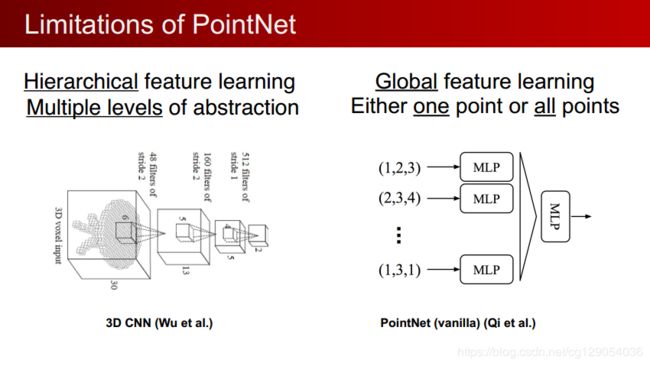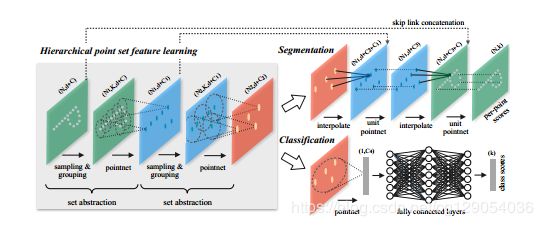PointNet++详解与代码
在之前的一篇文章《PointNet:3D点集分类与分割深度学习模型》中分析了PointNet网络是如何进行3D点云数据分类与分割的。但是PointNet存在的一个缺点是无法获得局部特征,这使得它很难对复杂场景进行分析。在PointNet++中,作者通过两个主要的方法进行了改进,使得网络能更好的提取局部特征。第一,利用空间距离(metric space distances),使用PointNet对点集局部区域进行特征迭代提取,使其能够学到局部尺度越来越大的特征。第二,由于点集分布很多时候是不均匀的,如果默认是均匀的,会使得网络性能变差,所以作者提出了一种自适应密度的特征提取方法。通过以上两种方法,能够更高效的学习特征,也更有鲁棒性。
目录
1.PointNet不足之处
2. PointNet++网络结构
2.1 Sample layer
2.2 Grouping layer
2.3 PointNet layer
2.4 点云分布不一致的处理方法
2.5 Point Feature Propagation for Set Segmentation
2.6 Classification
2.7 Part Segmentation
2.8 Scene Segmentation
3. 参考资料
1.PointNet不足之处
在卷积神经网络中,3D CNN和2D CNN很像,也可以通过多级学习不断进行提取,同时也具有着卷积的平移不变性。
而在PointNet中 网络对每一个点做低维到高维的映射进行特征学习,然后把所有点映射到高维的特征通过最大池化最终表示全局特征。从本质上来说,要么对一个点做操作,要么对所有点做操作,实际上没有局部的概念(loal context) 。同时也缺少local context 在平移不变性上也有局限性。(世界坐标系和局部坐标系)。对点云数据做平移操作后,所有的数据都将发生变化,导致所有的特征,全局特征都不一样了。对于单个的物体还好,可以将其平移到坐标系的中心,把他的大小归一化到一个球中,但是在一个场景中有多个物体时则不好办,需要对哪个物体做归一化呢?
在PointNet++中,作者利用所在空间的距离度量将点集划分(partition)为有重叠的局部区域。在此基础上,首先在小范围中从几何结构中提取局部特征(浅层特征),然后扩大范围,在这些局部特征的基础上提取更高层次的特征,直到提取到整个点集的全局特征。可以发现,这个过程和CNN网络的特征提取过程类似,首先提取低级别的特征,随着感受野的增大,提取的特征level越来越高。
PointNet++需要解决两个关键的问题:第一,如何将点集划分为不同的区域;第二,如何利用特征提取器获取不同区域的局部特征。这两个问题实际上是相关的,要想通过特征提取器来对不同的区域进行特征提取,需要每个分区具有相同的结构。这里同样可以类比CNN来理解,在CNN中,卷积块作为基本的特征提取器,对应的区域都是(n, n)的像素区域。而在3D点集当中,同样需要找到结构相同的子区域,和对应的区域特征提取器。
在本文中,作者使用了PointNet作为特征提取器,另外一个问题就是如何来划分点集从而产生结构相同的区域。作者使用邻域球来定义分区,每个区域可以通过中心坐标和半径来确定。中心坐标的选取,作者使用了最远点采样算法算法来实现(farthest point sampling (FPS) algorithm)。
2. PointNet++网络结构
PointNet++是PointNet的延伸,在PointNet的基础上加入了多层次结构(hierarchical structure),使得网络能够在越来越大的区域上提供更高级别的特征。
网络的每一组set abstraction layers主要包括3个部分:Sampling layer, Grouping layer and PointNet layer。
· Sample layer:主要是对输入点进行采样,在这些点中选出若干个中心点;
· Grouping layer:是利用上一步得到的中心点将点集划分成若干个区域;
· PointNet layer:是对上述得到的每个区域进行编码,变成特征向量。
每一组提取层的输入是![]() ,其中N是输入点的数量,d是坐标维度,C是特征维度。输出是
,其中N是输入点的数量,d是坐标维度,C是特征维度。输出是![]() ,其中N'是输出点的数量,d是坐标维度不变,C'是新的特征维度。下面详细介绍每一层的作用及实现过程。
,其中N'是输出点的数量,d是坐标维度不变,C'是新的特征维度。下面详细介绍每一层的作用及实现过程。
2.1 Sample layer
使用farthest point sampling(FPS)选择N'个点,至于为什么选择使用这种方法选择点,文中提到相比于随机采样,这种方法能更好的的覆盖整个点集。具体选择多少个中心点,数量怎么确定,可以看做是超参数视数据规模来定。
FPS算法原理为:
- 从点云中选取第一个点A作为查询点,从剩余点中,选取一个距离最远的点B;
- 以取出来的点A,B作为查询点,从剩余点中,取距离最远的点C。此时,由于已经取出来的点的个数超过1,需要同时考虑所有查询点(A,B)。方法如下:
- 对于剩余点中的任意一个点P,计算该点P到已经选中的点集中所有点(A, B)的距离;取与点A和B的距离最小值作为该点到已选点集的距离d;
- 计算出每个剩余点到点集的距离后,选取距离最大的那个点,即为点C。
- 重复第2步,一直采样到N'个点为止。
其Python实现代码为:
def farthest_point_sample(xyz, npoint):
"""
Input:
xyz: pointcloud data, [B, N, 3]
npoint: number of samples
Return:
centroids: sampled pointcloud index, [B, npoint, 3]
"""
device = xyz.device
B, N, C = xyz.shape
centroids = torch.zeros(B, npoint, dtype=torch.long).to(device) # 采样点矩阵(B, npoint)
distance = torch.ones(B, N).to(device) * 1e10 # 采样点到所有点距离(B, N)
farthest = torch.randint(0, N, (B,), dtype=torch.long).to(device) # 最远点,初试时随机选择一点点
batch_indices = torch.arange(B, dtype=torch.long).to(device) # batch_size 数组
for i in range(npoint):
centroids[:, i] = farthest # 更新第i个最远点
centroid = xyz[batch_indices, farthest, :].view(B, 1, 3) # 取出这个最远点的xyz坐标
dist = torch.sum((xyz - centroid) ** 2, -1) # 计算点集中的所有点到这个最远点的欧式距离
mask = dist < distance
distance[mask] = dist[mask] # 更新distances,记录样本中每个点距离所有已出现的采样点的最小距离
farthest = torch.max(distance, -1)[1] # 返回最远点索引
return centroids2.2 Grouping layer
这一层使用Ball query方法对sample layers采样的点生成![]() 个对应的局部区域,根据论文中的意思,这里使用到两个超参数 ,一个是每个区域中点的数量K,另一个是query的半径r。这里半径应该是占主导的,在某个半径的球内找点,点的数量上限是K。球的半径和每个区域中点的数量都是超参数。
个对应的局部区域,根据论文中的意思,这里使用到两个超参数 ,一个是每个区域中点的数量K,另一个是query的半径r。这里半径应该是占主导的,在某个半径的球内找点,点的数量上限是K。球的半径和每个区域中点的数量都是超参数。
代码为:
def square_distance(src, dst):
"""
Calculate Euclid distance between each two points.
src^T * dst = xn * xm + yn * ym + zn * zm;
sum(src^2, dim=-1) = xn*xn + yn*yn + zn*zn;
sum(dst^2, dim=-1) = xm*xm + ym*ym + zm*zm;
dist = (xn - xm)^2 + (yn - ym)^2 + (zn - zm)^2
= sum(src**2,dim=-1)+sum(dst**2,dim=-1)-2*src^T*dst
Input:
src: source points, [B, N, C]
dst: target points, [B, M, C]
Output:
dist: per-point square distance, [B, N, M]
"""
B, N, _ = src.shape
_, M, _ = dst.shape
dist = -2 * torch.matmul(src, dst.permute(0, 2, 1))
dist += torch.sum(src ** 2, -1).view(B, N, 1)
dist += torch.sum(dst ** 2, -1).view(B, 1, M)
return dist
def query_ball_point(radius, nsample, xyz, new_xyz):
"""
Input:
radius: local region radius
nsample: max sample number in local region
xyz: all points, [B, N, 3]
new_xyz: query points, [B, S, 3]
Return:
group_idx: grouped points index, [B, S, nsample]
"""
device = xyz.device
B, N, C = xyz.shape
_, S, _ = new_xyz.shape
group_idx = torch.arange(N, dtype=torch.long).to(device).view(1, 1, N).repeat([B, S, 1])
sqrdists = square_distance(new_xyz, xyz)
group_idx[sqrdists > radius ** 2] = N
group_idx = group_idx.sort(dim=-1)[0][:, :, :nsample]
group_first = group_idx[:, :, 0].view(B, S, 1).repeat([1, 1, nsample])
mask = group_idx == N
group_idx[mask] = group_first[mask]
return group_idx2.3 PointNet layer
这一层是PointNet网络,输入为局部区域:![]() 。输出是
。输出是![]() 。需要注意的是,在输入到网络之前,会把该区域中的点变成围绕中心点的相对坐标。作者提到,这样做能够获取点与点之间的关系。至此则完成了set abstraction工作,set abstraction代码为:
。需要注意的是,在输入到网络之前,会把该区域中的点变成围绕中心点的相对坐标。作者提到,这样做能够获取点与点之间的关系。至此则完成了set abstraction工作,set abstraction代码为:
class PointNetSetAbstraction(nn.Module):
def __init__(self, npoint, radius, nsample, in_channel, mlp, group_all):
super(PointNetSetAbstraction, self).__init__()
self.npoint = npoint
self.radius = radius
self.nsample = nsample
self.mlp_convs = nn.ModuleList()
self.mlp_bns = nn.ModuleList()
last_channel = in_channel
for out_channel in mlp:
self.mlp_convs.append(nn.Conv2d(last_channel, out_channel, 1))
self.mlp_bns.append(nn.BatchNorm2d(out_channel))
last_channel = out_channel
self.group_all = group_all
def forward(self, xyz, points):
"""
Input:
xyz: input points position data, [B, C, N]
points: input points data, [B, D, N]
Return:
new_xyz: sampled points position data, [B, C, S]
new_points_concat: sample points feature data, [B, D', S]
"""
xyz = xyz.permute(0, 2, 1)
if points is not None:
points = points.permute(0, 2, 1)
if self.group_all:
new_xyz, new_points = sample_and_group_all(xyz, points)
else:
new_xyz, new_points = sample_and_group(self.npoint, self.radius, self.nsample, xyz, points)
# new_xyz: sampled points position data, [B, npoint, C]
# new_points: sampled points data, [B, npoint, nsample, C+D]
new_points = new_points.permute(0, 3, 2, 1) # [B, C+D, nsample,npoint]
for i, conv in enumerate(self.mlp_convs):
bn = self.mlp_bns[i]
new_points = F.relu(bn(conv(new_points)))
new_points = torch.max(new_points, 2)[0]
new_xyz = new_xyz.permute(0, 2, 1)
return new_xyz, new_points2.4 点云分布不一致的处理方法
点云分布不一致时,每个子区域中如果在生成的时候使用相同的半径r,会导致有些区域采样点过少。
作者提到这个问题需要解决,并且提出了两个方法:Multi-scale grouping (MSG) and Multi-resolution grouping (MRG)。下面是论文当中的示意图。
下面分别介绍一下这两种方法。
第一种多尺度分组(MSG),对于同一个中心点,如果使用3个不同尺度的话,就分别找围绕每个中心点画3个区域,每个区域的半径及里面的点的个数不同。对于同一个中心点来说,不同尺度的区域送入不同的PointNet进行特征提取,之后concat,作为这个中心点的特征。也就是说MSG实际上相当于并联了多个hierarchical structure,每个结构中心点不变,但是区域范围不同。PointNet的输入和输出尺寸也不同,然后几个不同尺度的结构在PointNet有一个Concat。代码是:
class PointNetSetAbstractionMsg(nn.Module):
def __init__(self, npoint, radius_list, nsample_list, in_channel, mlp_list):
super(PointNetSetAbstractionMsg, self).__init__()
self.npoint = npoint
self.radius_list = radius_list
self.nsample_list = nsample_list
self.conv_blocks = nn.ModuleList()
self.bn_blocks = nn.ModuleList()
for i in range(len(mlp_list)):
convs = nn.ModuleList()
bns = nn.ModuleList()
last_channel = in_channel + 3
for out_channel in mlp_list[i]:
convs.append(nn.Conv2d(last_channel, out_channel, 1))
bns.append(nn.BatchNorm2d(out_channel))
last_channel = out_channel
self.conv_blocks.append(convs)
self.bn_blocks.append(bns)
def forward(self, xyz, points):
"""
Input:
xyz: input points position data, [B, C, N]
points: input points data, [B, D, N]
Return:
new_xyz: sampled points position data, [B, C, S]
new_points_concat: sample points feature data, [B, D', S]
"""
xyz = xyz.permute(0, 2, 1)
if points is not None:
points = points.permute(0, 2, 1)
B, N, C = xyz.shape
S = self.npoint
new_xyz = index_points(xyz, farthest_point_sample(xyz, S))
new_points_list = []
for i, radius in enumerate(self.radius_list):
K = self.nsample_list[i]
group_idx = query_ball_point(radius, K, xyz, new_xyz)
grouped_xyz = index_points(xyz, group_idx)
grouped_xyz -= new_xyz.view(B, S, 1, C)
if points is not None:
grouped_points = index_points(points, group_idx)
grouped_points = torch.cat([grouped_points, grouped_xyz], dim=-1)
else:
grouped_points = grouped_xyz
grouped_points = grouped_points.permute(0, 3, 2, 1) # [B, D, K, S]
for j in range(len(self.conv_blocks[i])):
conv = self.conv_blocks[i][j]
bn = self.bn_blocks[i][j]
grouped_points = F.relu(bn(conv(grouped_points)))
new_points = torch.max(grouped_points, 2)[0] # [B, D', S]
new_points_list.append(new_points)
new_xyz = new_xyz.permute(0, 2, 1)
new_points_concat = torch.cat(new_points_list, dim=1)
return new_xyz, new_points_concat另一种是多分辨率分组(MRG)。MSG很明显会影响降低运算速度,所以提出了MRG,这种方法应该是对不同level的grouping做了一个concat,但是由于尺度不同,对于low level的先放入一个pointnet进行处理再和high level的进行concat。感觉和ResNet中的跳跃连接有点类似。
在这部分,作者还提到了一种random input dropout(DP)的方法,就是在输入到点云之前,对点集进行随机的Dropout, 比例为95%,也就是说进行95%的比例采样。
2.5 Point Feature Propagation for Set Segmentation
对于点云分割任务,我们还需要将点集上采样回原始点集数量,这里使用了分层的差值方法。代码为:
def forward(self, xyz1, xyz2, points1, points2):
"""
Input:
xyz1: input points position data, [B, C, N]
xyz2: sampled input points position data, [B, C, S]
points1: input points data, [B, D, N]
points2: input points data, [B, D, S]
Return:
new_points: upsampled points data, [B, D', N]
"""
xyz1 = xyz1.permute(0, 2, 1)
xyz2 = xyz2.permute(0, 2, 1)
points2 = points2.permute(0, 2, 1)
B, N, C = xyz1.shape
_, S, _ = xyz2.shape
if S == 1:
interpolated_points = points2.repeat(1, N, 1)
else:
dists = square_distance(xyz1, xyz2)
dists, idx = dists.sort(dim=-1)
dists, idx = dists[:, :, :3], idx[:, :, :3] # [B, N, 3]
dist_recip = 1.0 / (dists + 1e-8)
norm = torch.sum(dist_recip, dim=2, keepdim=True)
weight = dist_recip / norm
interpolated_points = torch.sum(index_points(points2, idx) * weight.view(B, N, 3, 1), dim=2)
if points1 is not None:
points1 = points1.permute(0, 2, 1)
new_points = torch.cat([points1, interpolated_points], dim=-1)
else:
new_points = interpolated_points
new_points = new_points.permute(0, 2, 1)
for i, conv in enumerate(self.mlp_convs):
bn = self.mlp_bns[i]
new_points = F.relu(bn(conv(new_points)))
return new_points2.6 Classification
class PointNet2ClsMsg(nn.Module):
def __init__(self):
super(PointNet2ClsMsg, self).__init__()
self.sa1 = PointNetSetAbstractionMsg(512, [0.1, 0.2, 0.4], [16, 32, 128], 0, [[32, 32, 64], [64, 64, 128], [64, 96, 128]])
self.sa2 = PointNetSetAbstractionMsg(128, [0.2, 0.4, 0.8], [32, 64, 128], 320, [[64, 64, 128], [128, 128, 256], [128, 128, 256]])
self.sa3 = PointNetSetAbstraction(None, None, None, 640 + 3, [256, 512, 1024], True)
self.fc1 = nn.Linear(1024, 512)
self.bn1 = nn.BatchNorm1d(512)
self.drop1 = nn.Dropout(0.4)
self.fc2 = nn.Linear(512, 256)
self.bn2 = nn.BatchNorm1d(256)
self.drop2 = nn.Dropout(0.4)
self.fc3 = nn.Linear(256, 40)
def forward(self, xyz):
B, _, _ = xyz.shape
l1_xyz, l1_points = self.sa1(xyz, None)
l2_xyz, l2_points = self.sa2(l1_xyz, l1_points)
l3_xyz, l3_points = self.sa3(l2_xyz, l2_points)
x = l3_points.view(B, 1024)
x = self.drop1(F.relu(self.bn1(self.fc1(x))))
x = self.drop2(F.relu(self.bn2(self.fc2(x))))
x = self.fc3(x)
x = F.log_softmax(x, -1)
return x
2.7 Part Segmentation
class PointNet2PartSeg(nn.Module):
def __init__(self, num_classes):
super(PointNet2PartSeg, self).__init__()
self.sa1 = PointNetSetAbstraction(npoint=512, radius=0.2, nsample=64, in_channel=3, mlp=[64, 64, 128], group_all=False)
self.sa2 = PointNetSetAbstraction(npoint=128, radius=0.4, nsample=64, in_channel=128 + 3, mlp=[128, 128, 256], group_all=False)
self.sa3 = PointNetSetAbstraction(npoint=None, radius=None, nsample=None, in_channel=256 + 3, mlp=[256, 512, 1024], group_all=True)
self.fp3 = PointNetFeaturePropagation(in_channel=1280, mlp=[256, 256])
self.fp2 = PointNetFeaturePropagation(in_channel=384, mlp=[256, 128])
self.fp1 = PointNetFeaturePropagation(in_channel=128, mlp=[128, 128, 128])
self.conv1 = nn.Conv1d(128, 128, 1)
self.bn1 = nn.BatchNorm1d(128)
self.drop1 = nn.Dropout(0.5)
self.conv2 = nn.Conv1d(128, num_classes, 1)
def forward(self, xyz):
# Set Abstraction layers
l1_xyz, l1_points = self.sa1(xyz, None)
l2_xyz, l2_points = self.sa2(l1_xyz, l1_points)
l3_xyz, l3_points = self.sa3(l2_xyz, l2_points)
# Feature Propagation layers
l2_points = self.fp3(l2_xyz, l3_xyz, l2_points, l3_points)
l1_points = self.fp2(l1_xyz, l2_xyz, l1_points, l2_points)
l0_points = self.fp1(xyz, l1_xyz, None, l1_points)
# FC layers
feat = F.relu(self.bn1(self.conv1(l0_points)))
x = self.drop1(feat)
x = self.conv2(x)
x = F.log_softmax(x, dim=1)
x = x.permute(0, 2, 1)
return x, feat
2.8 Scene Segmentation
class PointNet2SemSeg(nn.Module):
def __init__(self, num_classes):
super(PointNet2SemSeg, self).__init__()
self.sa1 = PointNetSetAbstraction(1024, 0.1, 32, 3, [32, 32, 64], False)
self.sa2 = PointNetSetAbstraction(256, 0.2, 32, 64 + 3, [64, 64, 128], False)
self.sa3 = PointNetSetAbstraction(64, 0.4, 32, 128 + 3, [128, 128, 256], False)
self.sa4 = PointNetSetAbstraction(16, 0.8, 32, 256 + 3, [256, 256, 512], False)
self.fp4 = PointNetFeaturePropagation(768, [256, 256])
self.fp3 = PointNetFeaturePropagation(384, [256, 256])
self.fp2 = PointNetFeaturePropagation(320, [256, 128])
self.fp1 = PointNetFeaturePropagation(128, [128, 128, 128])
self.conv1 = nn.Conv1d(128, 128, 1)
self.bn1 = nn.BatchNorm1d(128)
self.drop1 = nn.Dropout(0.5)
self.conv2 = nn.Conv1d(128, num_classes, 1)
def forward(self, xyz):
l1_xyz, l1_points = self.sa1(xyz, None)
l2_xyz, l2_points = self.sa2(l1_xyz, l1_points)
l3_xyz, l3_points = self.sa3(l2_xyz, l2_points)
l4_xyz, l4_points = self.sa4(l3_xyz, l3_points)
l3_points = self.fp4(l3_xyz, l4_xyz, l3_points, l4_points)
l2_points = self.fp3(l2_xyz, l3_xyz, l2_points, l3_points)
l1_points = self.fp2(l1_xyz, l2_xyz, l1_points, l2_points)
l0_points = self.fp1(xyz, l1_xyz, None, l1_points)
x = self.drop1(F.relu(self.bn1(self.conv1(l0_points))))
x = self.conv2(x)
x = F.log_softmax(x, dim=1)
return x
3. 参考资料
PointNet++官网链接:http://stanford.edu/~rqi/pointnet2/
PointNet++代码:https://github.com/yanx27/Pointnet_Pointnet2_pytorch
PointNet++的pytorch实现代码阅读
PointNet++作者视频讲解文字版:https://www.cnblogs.com/yibeimingyue/p/12002469.html



